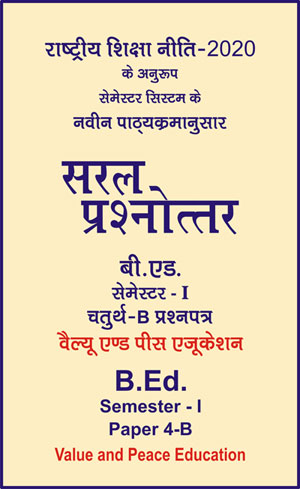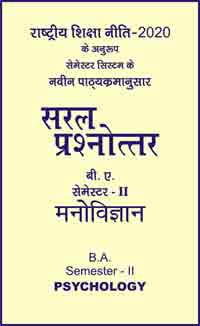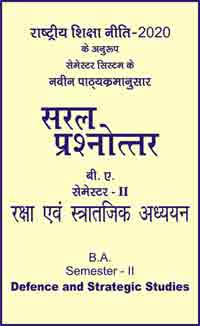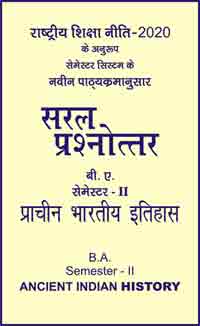|
बी एड - एम एड >> बी.एड. सेमेस्टर-1 प्रश्नपत्र-IV-B - वैल्यू एण्ड पीस एजुकेशन बी.एड. सेमेस्टर-1 प्रश्नपत्र-IV-B - वैल्यू एण्ड पीस एजुकेशनसरल प्रश्नोत्तर समूह
|
5 पाठक हैं |
||||||
बी.एड. सेमेस्टर-1 प्रश्नपत्र-IV-B - वैल्यू एण्ड पीस एजुकेशन (अंग्रेजी भाषा में)
Question- Write a detailed note on approaches to Value Education.
Answer -
Values education is an explicit attempt to teach about values and/or valuing. Superka, Ahrens, & Hedstrom (1976) state there are five basic approaches to values education: inculcation, moral development, analysis, values clarification, and action learning. This text was used as the major source for the organization of the following presentation.
Inculcation
Most educators viewing values education from the perspective of inculcation see values as socially or culturally accepted standards or rules of behavior. Valuing is therefore considered a process of the student identifying with and accepting the standards or norms of the important individuals and institutions within his society. The student “incorporates” these values into his or her own value system. These educators take a view of human nature in which the individual is treated, during the inculcation process, as a reactor rather than as an initiator. Extreme advocates such as Talcott Parsons (1951) believe that the needs and goals of society should transcend and even define the needs and goals of the individuals.
However, advocates who consider an individual to be a free, self-fulfilling participant in society tend to inculcate values as well, especially values such as freedom to learn, human dignity, justice, and self-exploration. Both the social- and individualistic-oriented advocates would argue the notion that certain values are universal and absolute. The source of these values is open to debate. On the one hand some advocates argue they derive from the natural order of the universe; others believe that values originate in an omnipotent Creator.
Moral Development
Educators adopting a moral development perspective believe that moral thinking develops in stages through a specific sequence. This approach is based primarily on the work of Lawrence Kohlberg (1969, 1984) as presented in his 6 stages and 25 “basic moral concepts.” This approach focuses primarily on moral values, such as fairness, justice, equity, and human dignity; other types of values (social, personal, and aesthetic) are usually not considered. It is assumed that students invariably progress developmentally in their thinking about moral issues. They can comprehend one stage above their current primary stage and exposure to the next higher level is essential for enhancing moral development. Educators attempt to stimulate students to develop more complex moral reasoning patterns through the sequential stages.
Kohlberg’s Levels of Moral Development
| Level | Stage | Characteristics of Stage/Level |
|---|---|---|
| A Preconventional | Stage 1 | Punishment-Obedience Orientation |
| Stage 2 | Instrumental Relativist Orientation | |
| B Conventional | Stage 3 | Interpersonal Concordance Orientation |
| Stage 4 | Authority and Social-Order Maintaining Orientation | |
| C Postconventional Autonomous, or Principled | Stage 4 | Social-Contact Legalistic Orientation |
| Stage 4 | Universal Ethical Principle Orientation |
Kohlberg’s view of human nature is similar to that presented in the ideas of other developmental psychologists such as Piaget (1932, 1962), Erikson (1950), and Loevinger et al. (1970). This perspective views the person as an active initiator and a reactor within the context of his or her environment; the individual cannot fully change the environment, but neither can the environment fully mold the individual. A person’s actions are the result of his or her feelings, thoughts, behaviors, and experiences. Although the environment can determine the content of one’s experiences, it cannot determine its form. Genetic structures already inside the person are primarily responsible for the way in which a person internalizes the content, and organizes and transforms it into personally meaningful data.
Analysis
The analysis approach to values education was developed mainly by social science educators. The approach emphasizes rational thinking and reasoning. The purpose of the analysis approach is to help students use logical thinking and the procedures of scientific investigation in dealing with values issues. Students are urged to provide verifiable facts about the correctness or value of the topics or issues under investigation. A major assumption is that valuing is the cognitive process of determining and justifying facts and beliefs derived from those facts. This approach concentrates primarily on social values rather than on the personal moral dilemmas presented in the moral development approach.
The rationalist (based on reasoning) and empiricist (based on experience) views of human nature seem to provide the philosophical basis for this approach. Its advocates state that the process of valuing can and should be conducted under the total authority of facts and reason (Scriven, 1966) and ‘guided not by the dictates of the heart and conscience, but by the rules and procedures of logic’ (Bond, 1970).
The teaching methods used by this approach generally center around individual and group study of social value problems and issues, library and field research, and rational class discussions. These are techniques widely used in social studies instruction.
A variety of higher-order cognitive and intellectual operations are frequently used (similar in many ways to those advocated members of the critical thinking movement). These include:
- stating the issues;
- questioning and substantiating in the relevance of statements;
- applying analogous cases to qualify and refine value positions;
- pointing out logical and empirical inconsistencies in arguments;
- weighing counter arguments; and
- seeking and testing evidence.
A representative instructional model is presented by Metcalf (1971):
- identify and clarify the value question;
- assemble purported facts;
- assess the truth of purported facts;
- clarify the relevance of facts;
- arrive at a tentative value decision; and
- test the value principle implied in the decision.
Additional support for this approach is provided by Ellis (1962), Kelly (1955), and Pepper (1947). The thinking techniques demonstrated by Mind Tools is an excellent example of strategies used in this approach.
Values Clarification
The values clarification approach arose primarily from humanistic psychology and the humanistic education movement as it attempted to implement the ideas and theories of Gordon Allport (1955), Abraham Maslow (1970), Carl Rogers (1969), and others. The central focus is on helping students use both rational thinking and emotional awareness to examine personal behavior patterns and to clarify and actualize their values. It is believed that valuing is a process of self-actualization, involving the sub-processes of choosing freely from among alternatives, reflecting carefully on the consequences of those alternatives, and prizing, affirming, and acting upon one’s choices. Values clarification is based predominately on the work of Raths, Harmin & Simon (1978), Simon & Kirschenbaum (1973), and Simon, Howe & Kirschenbaum (1972).
Whereas the inculcation approach relies generally on outside standards and the moral development and analysis approaches rely on logical and empirical processes, the values clarification approach relies on an internal cognitive and affective decision making process to decide which values are positive and which are negative. It is therefore an individualistic rather than a social process of values education.
From this perspective, the individual, if he or she is allowed the opportunity of being free to be his or her true self, makes choices and decisions affected by the internal processes of willing, feeling, thinking, and intending. It is assumed that through self-awareness, the person enters situations already pointed or set in certain directions. As the individual develops, the making of choices will more often be based on conscious, self-determined thought and feeling. It is advocated that the making of choices, as a free being, which can be confirmed or denied in experience, is a preliminary step in the creation of values (Moustakas, 1966).
Within the clarification framework a person is seen as an initiator of interaction with society and environment. The educator should assist the individual to develop his or her internal processes, thereby allowing them, rather than external factors, to be the prime determinants of human behavior; the individual should be free to change the environment to meet his or her needs.
Methods used in the values clarification approach include large- and small-group discussion; individual and group work; hypothetical, contrived, and real dilemmas; rank orders and forced choices; sensitivity and listening techniques; songs and artwork; games and simulations; and personal journals and interviews; self-analysis worksheet. A vital component is a leader who does not attempt to influence the selection of values. Like the moral development approach, values clarification assumes that the valuing process is internal and relative, but unlike the
inculcation and developmental approaches it does not posit any universal set of appropriate values.
A sevenfold process describing the guidelines of the values clarification approach was formulated by Simon et al. (1972):
- choosing from alternatives;
- choosing freely;
- prizing one’s choice;
- affirming one’s choice;
- acting upon one’s choice; and
- acting repeatedly, over time.
Additional theorists providing support for the values clarification approach include Asch (1952) and G. Murphy (1958).
Action Learning
The action learning approach is derived from a perspective that valuing includes a process of implementation as well as development. That is, it is important to move beyond thinking and feeling to acting. The approach is related to the efforts of some social studies educators to emphasize community-based rather than classroom-based learning experiences. In some ways it is the least developed of the five approaches. However, a variety of recent programs have demonstrated the effectiveness of the techniques advocated by this approach (e.g., Cottom, 1996; Gauld, 1993; Solomon et al., 1992).
Advocates of the action learning approach stress the need to provide specific opportunities for learners to act on their values. They see valuing primarily as a process of self-actualization in which individuals consider alternatives; choose freely from among those alternatives; and prize, affirm, and act on their choices. They place more emphasis on action-taking inside and outside the classroom than is reflected in the moral development, analysis, and values clarification processes.
Values are seen to have their source neither in society nor in the individual but in the interaction between the person and the society; the individual cannot be described outside of his or her context. The process of self-actualization, so important to the founders of the values clarification approach, is viewed as being tempered by social factors and group pressures. In this way it is more related to Maslow’s (1971) level of transcendence which he discussed towards the end of his career.
A problem-solving/decision making model and related techniques that can serve as a sound beginning for this approach is presented by Huitt (1992):
(1) Input Phase: a problem is perceived and an attempt is made to understand the situation or problem:
- Identify the problem(s) and state it (them) clearly and concisely.
- State the criteria that will be used to evaluate possible alternatives to the problem as well as the effectiveness of selected solutions; state any identified boundaries of acceptable alternatives, important values or feelings to be considered, or results that should be avoided.
- Gather information or facts relevant to solving the problem or making a decision.
(2) Processing Phase : Alternatives are generated and evaluated and a solution is selected :
- Develop alternatives or possible solutions.
- Evaluate the generated alternatives vis-a-vis the stated criteria.
- Develop a solution that will successfully solve the problem (diagnose possible problems with the solution and implications of these problems; consider the worst that can happen if the solution is implemented; evaluate in terms of overall "feelings" and "values".
(3) Output Phase : Includes planning for and implementing the solution :
- Develop plan for implementation (sufficiently detailed to allow for successful implementation).
- Establish methods and criteria for evaluation of implementation and success.
- Implement the solution.
(4) Review Phase : The solution is evaluated and modifications are made, if necessary :
- Evaluating implementation of the solution (an ongoing process).
- Evaluating the effectiveness of the solution.
- Modifying the solution in ways suggested by the evaluation process.
Dhruv
image - 55
|
|||||













